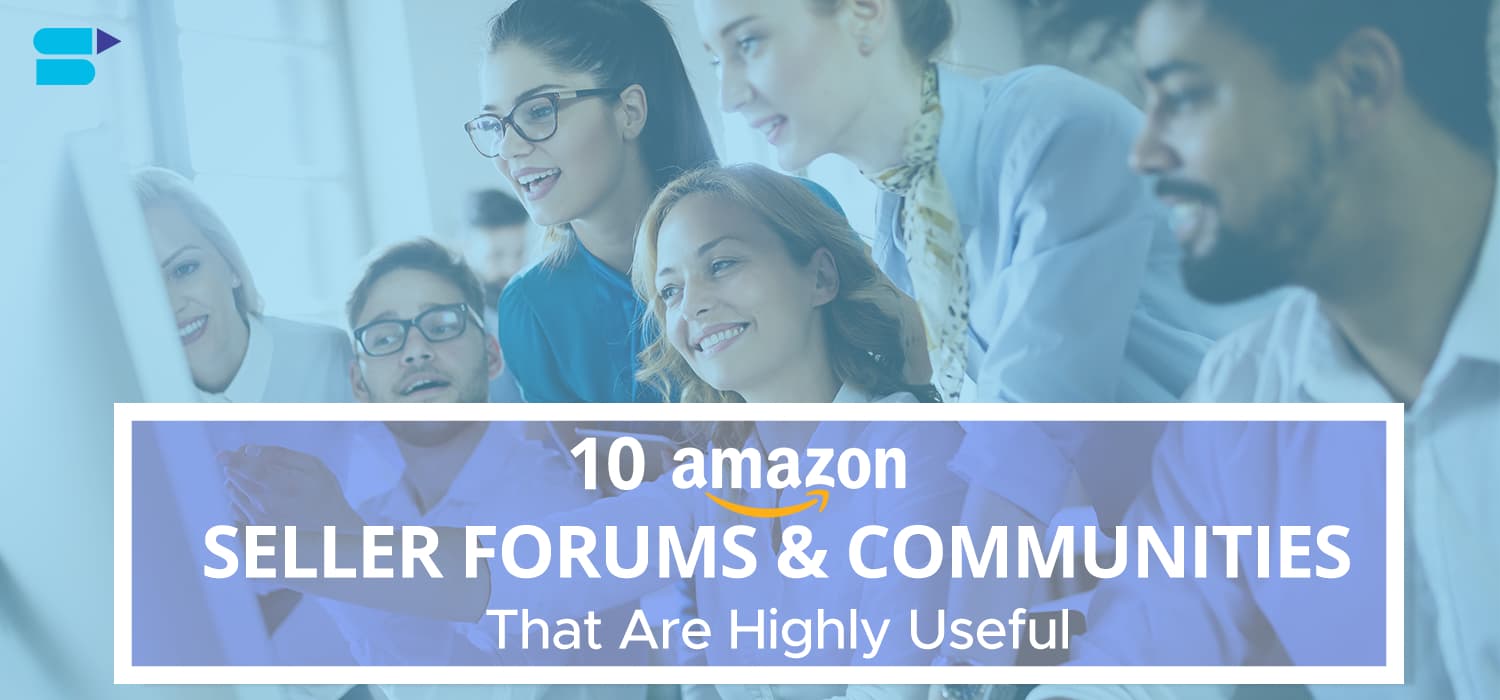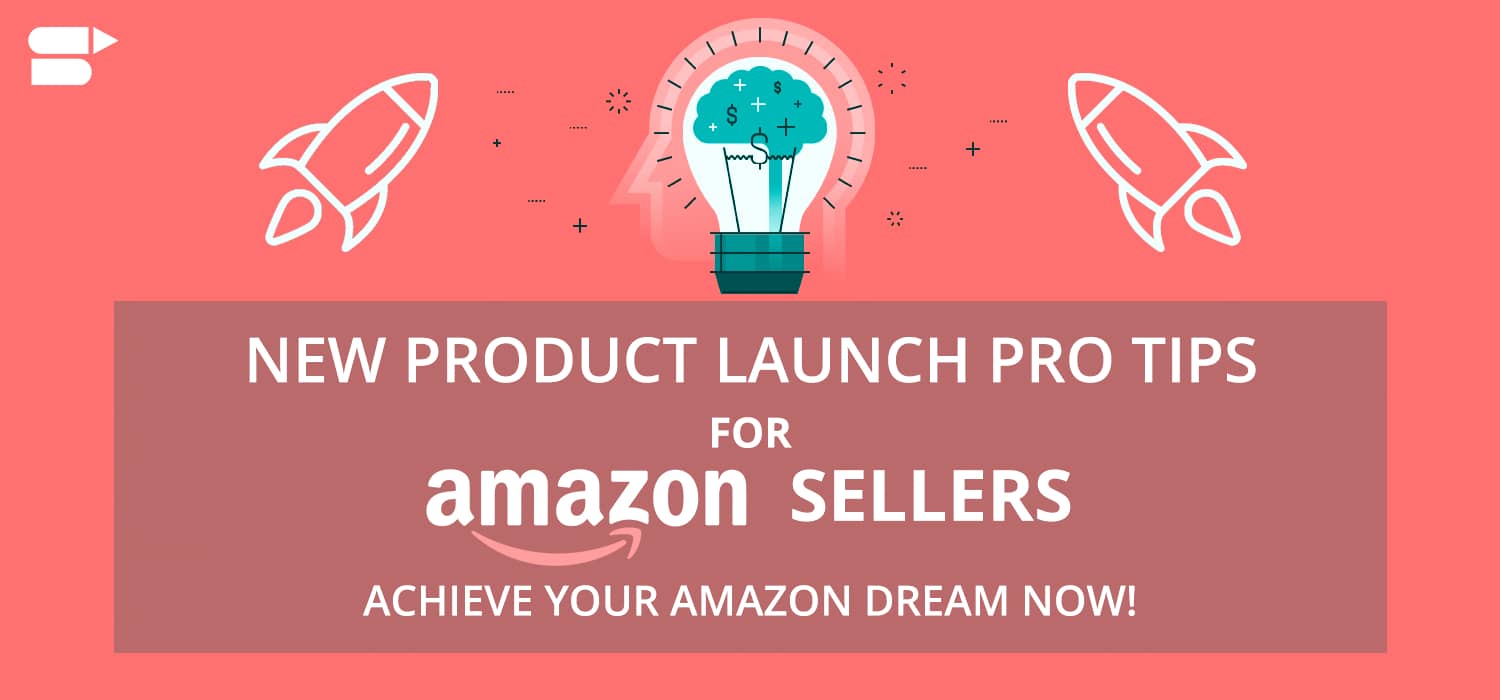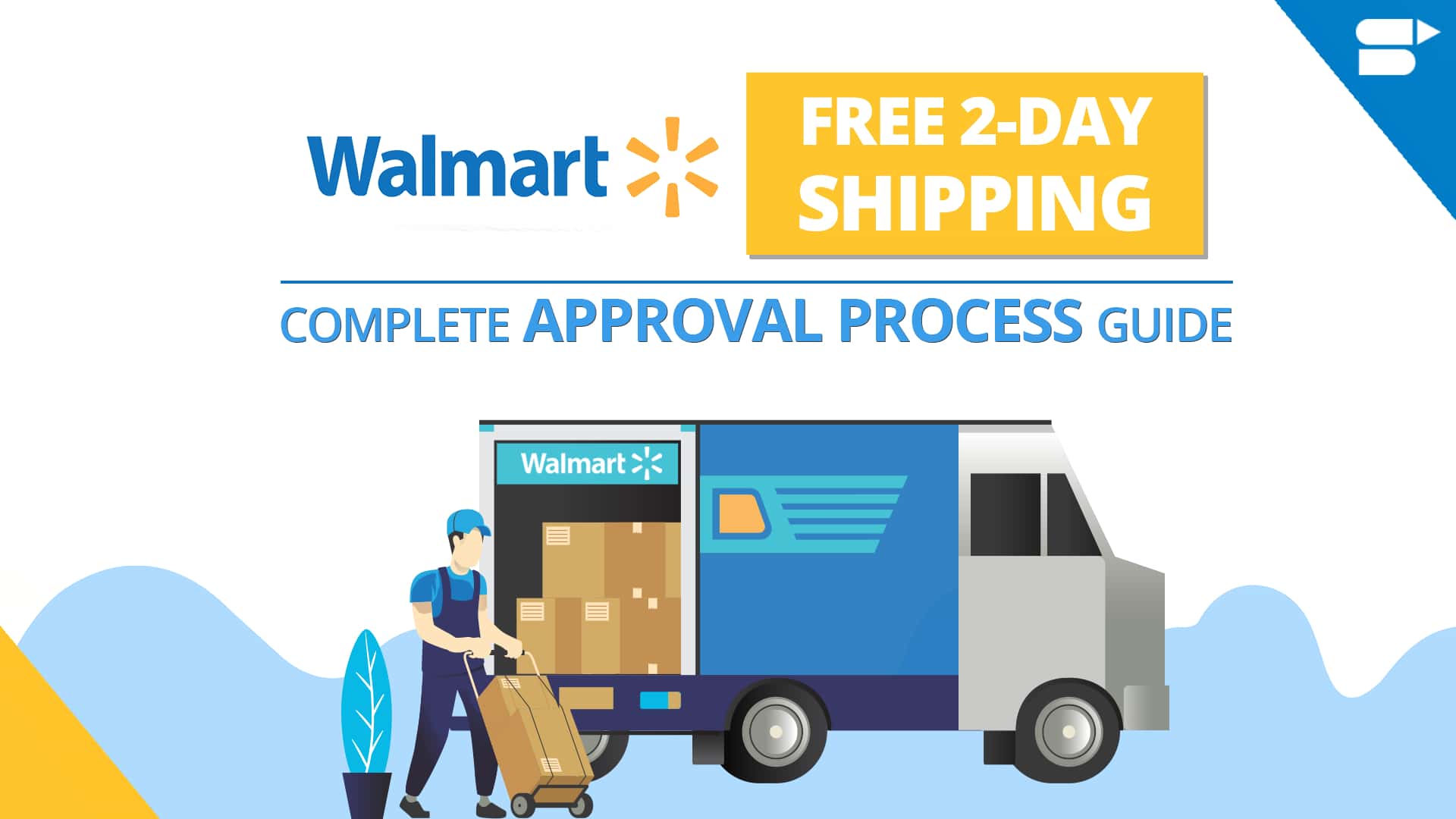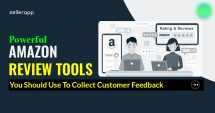Prime Day vs Black Friday. They look similar, but not the same
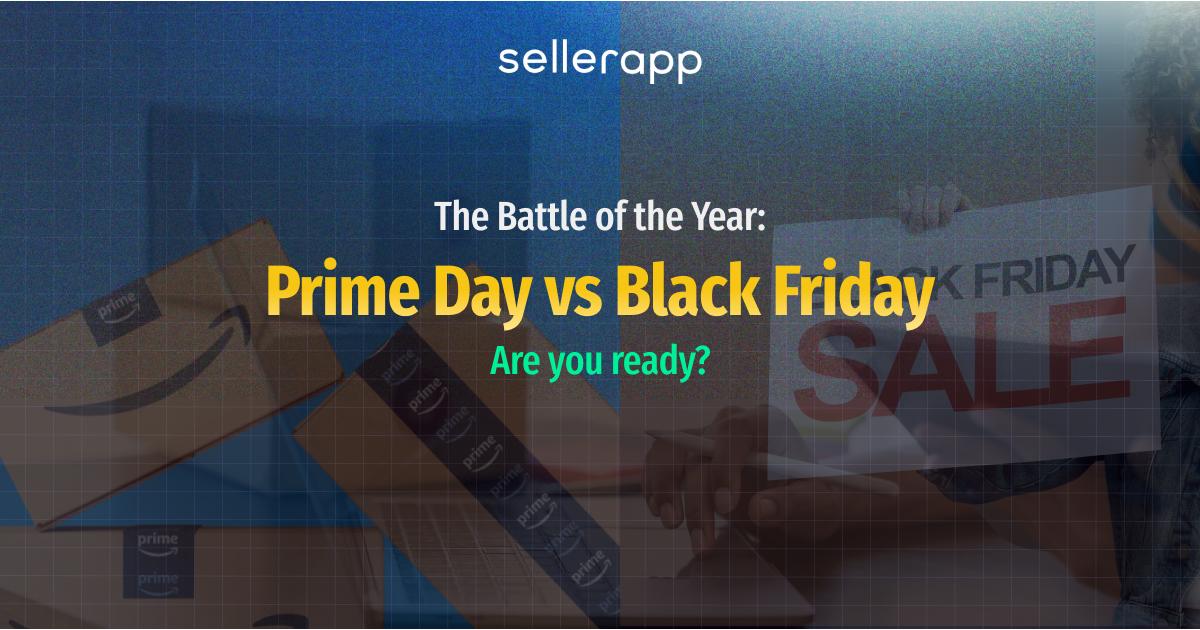
In the uber-competitive domain of marketplace e-commerce, two events, Amazon Prime Day and Black Friday, rule the online retail universe, bringing in billions in sales and changing what the shopping season really means for brands and consumers alike.
Prime Day started as Amazon’s birthday celebration, a one-day loyalty event that turned into a mid-year global sales craze. Way back in the day, it used to be a simple members-only perk, but now that it’s open to everyone, it drives immense increases in traffic and sales.
So, while this results in an increase in ad spend for sellers in June and July, it’s 100% effective, as it not only increases product sales but also product discovery and brand visibility across every category.
Black Friday, on the other hand, is also similarly amazing. Having evolved from chaotic in-store sales to a data-driven digital war, it now sets the tone for Q4 competition and influences pricing weeks before the holiday rush.
Now you must be thinking about which event sells more.
1) Well, it’s whichever fits your strategy better. You need to understand that Prime Day rewards versatile and fast-moving sellers who can shift inventory and optimize ads in real time.
2) Whereas, Black Friday rewards strong brands that can sustain deep discounts, manage fulfillment pressure, and still protect margins through the end of the year.
We will help you understand the difference and how you can turn prime day vs black friday into a coordinated sale instead of two disconnected sales spikes.
What Is Amazon Prime Day vs Black Friday?
You know Prime Day vs Black Friday don’t behave the same way at all, right? From a distance, they look like two massive sales events. But in reality, they attract different shoppers, trigger different marketplace behaviors, and serve totally different purposes.
Amazon Prime Day feels like Amazon flipping a switch on platform-wide demand.
It’s Amazon’s event, built to energize Prime members and break the quiet mid-year period. When it was first launched, sellers treated it like a bonus that would spike their sales. But over the years this has changed.
Amazon pushes so much traffic through the platform that the seller gets a rare chance to watch how their ASINs behave under pressure, what converts, what keywords pop, what creative fails, and what price points shoppers tolerate.
Most sellers who take Prime Day seriously use it to answer questions like
- Can this product hold a 20-30% discount without killing margins?
- Which keywords drive the cleanest conversions when traffic surges?
- Do my images still win the click when competition gets aggressive?
Because during Prime Day, the spike in impressions, clicks, and conversions usually boosts your organic rank, strengthens keyword velocity, and stabilizes your BSR right before Q4. That early lift matters more than people talk about. A strong post Prime Day ranking makes your Q4 10x easier.
Black Friday is completely different.
It’s not just Amazon’s event, but it’s the world’s event. Shoppers show up already in buying mode. They’ve been waiting to spend. They’ve made lists, and they’ve compared competitors. They are intentional. And because the entire world is running deals, Amazon becomes one stop in a larger shopping event.
This shifts the competitive landscape dramatically:
- CPCs shoot up fast
- inventory mistakes become unforgiving
- restock limits tighten right when you need stock the most
- 3P and 1P compete shoulder-to-shoulder for the same keywords
- price sensitivity gets extreme because shoppers are comparing across retailers
In prime day vs black friday, one event is for you to experiment, and the other is where you execute with precision.
It’s the moment all the Prime Day learnings turn into action: your best-performing ASINs, your strongest creatives, your proven keyword sets, and your tightest pricing logic.
What’s Going On in a Shopper’s Mind During Prime Day vs Black Friday?
If you strip away the hype, what truly separates Prime Day vs Black Friday is timing, and timing changes everything. The same shopper behaves differently depending on the month, their emotional context, and what stage they’re in within their annual spending cycle.
Prime Day
Prime Day falls right in the middle of the retail year, typically in July, when consumers aren’t in “holiday mode” yet. They’re not shopping out of obligation but out of curiosity, convenience, or a sense of reward. That’s why Prime Day purchases often reflect a “treat yourself” mentality.
Buyers aren’t racing to finish gift lists. They’re picking up things they postponed earlier in the year, which includes upgraded tech, home gadgets, wellness tools, and premium versions of everyday products. This leads to:
- Higher discovery rates: Consumers are more open to new brands and ASINs.
- Shorter decision periods: Less comparison fatigue means faster conversions.
- Lower deal dependency: Many buyers respond to moderate discounts if relevance and convenience are strong.
For most sellers, Prime Day isn’t really about “massive discounts.” It’s more like a mid-year stress test. The rest of the retail world is quiet, shoppers aren’t in holiday mode yet, and that calm creates a surprisingly useful environment to figure out whether your listing actually has legs.
You start to see which keywords genuinely move the needle, which ASINs can handle real traffic, and which products only convert when the entire world is in a buying frenzy. That kind of clarity is hard to get in Q4, when everything sells simply because people need gifts.
And then there’s the part nobody talks about enough: the afterglow. A ton of Prime Day shoppers click, compare, add to cart, or save your listing for later and then disappear. You don’t feel it immediately, but they show up again during Black Friday, Cyber Monday, or even early holiday shopping in October. They already know who you are, so your ads land cheaper, your conversion rates look healthier, and your listings feel “familiar” to them.
During Prime Day vs Black Friday, sellers who’ve been through enough cycles eventually realize Prime Day isn’t the finish line it’s the setup. The real money comes later, when all that July attention quietly turns into November revenue.
Black Friday
On the other hand, Black Friday vs. Prime Day is completely different. By the time November arrives, shoppers aren’t just scrolling they’re under pressure to get their list of products.
Every deal that pops up feels like it might be the one they’ll regret missing if they wait even a day longer. That combination of urgency and fear of overpaying shapes how they behave on Amazon in ways that are almost impossible to replicate at any other time of the year.
Shoppers come in with intentions. They’ve been tracking prices for weeks, sometimes months, especially for big-ticket products. Many already know what they want, and they’re just waiting for the price to drop low enough to make the final purchase.
And because so much of Black Friday spending is for other people, the psychology changes again. Shoppers suddenly prioritize safe, reliable, well-reviewed items. This is why categories like home, kitchen, grooming tools, and electronics stand out, as they’re practical, familiar, and easy to justify as gifts. Risky or experimental products usually don’t stand a chance unless they’ve already built trust earlier in the year.
Next is pricing. Consumers behave incredibly sensitively to even tiny differences in price or delivery promises. A product that feels fairly priced in July can feel overpriced in November, simply because everyone expects the market to deliver its cheapest prices now.
Also there’s advertising. CPCs grow fast, and the marketplace feels like it’s running on caffeine. But the funny thing is, the intent is so high that even though you pay more for every click, those clicks convert better than almost any other time of year.
A small, often overlooked factor is delivery anxiety. Shoppers don’t want to deal with late arrivals or last-minute chaos. If your listing shows faster or more reliable delivery, it can outperform a cheaper competitor purely because customers don’t want holiday stress. In November, peace of mind is a selling point.
And because of that pressure, shoppers’ behavior becomes sharp, focused, and incredibly predictable. Sellers who understand the underlying psychology end up with better sales.
Behavioral Data & Buyer Journey Difference
The data reinforces these psychological differences:
| Metric | Prime Day | Black Friday |
|---|---|---|
| Average Order Value (AOV) | Moderate, buyers purchase 1–2 items for themselves | High, larger baskets, gift bundles, big-ticket items |
| Conversion Rate | Fast decisions, lower comparison behavior | Very high, but more price-driven |
| Repeat Purchase Probability (30–60 days) | Higher, especially for consumables or lifestyle items | Lower gifting season purchases have limited repeat value |
| Top-Performing Categories | Tech accessories, smart home, kitchen, personal care | Electronics, toys, fashion, home décor |
| Buyer Intent | Exploratory, self-rewarding | Urgent, gifting-focused |
| Ad Strategy Payoff | Visibility & ranking gains | Profitability & inventory turnover |
Traffic, Conversion, and AOV Data Comparison
Both prime day vs black friday pull record-breaking traffic to Amazon, but the way that traffic behaves and converts is completely different.
Prime Day’s traffic spike is steep and short-lived. The event period is tightly controlled, usually 48 hours, and awareness builds sharply about a week prior as Amazon starts its pre-event teasers. Once the event starts, session volume can jump 8-10x within hours, then decrease just as fast. This “flash flood” behavior creates operational pressure on sponsored ads, where CPCs can climb by 200–300% in the first few hours.
Because the surge hits so abruptly, sellers don’t have the luxury of adjusting things once the event is live. You will be starting too late if your budgets, bids, listings, deals, and inventory aren’t already in place before the spike begins.
Black Friday’s ramp-up is slower and broader. Traffic starts climbing as early as mid-November, driven by early-bird deals and off-Amazon discovery (Google, TikTok, and brand sites).
The real surge doesn’t just peak on Black Friday itself, it stretches across Cyber Monday and the week after, creating a longer conversion tail.
If you plan your budget linearly, you often miss this most profitable ROAS during Black Friday week, which actually happens after the event, as retargeting and abandoned-cart campaigns convert hesitant shoppers.
What are the conversion patterns?
Although intent levels are variable, Prime Day conversion rates are high. Due to Amazon’s homepage curation and lightning deal visibility, a large number of customers explore reactively. Depending on the category and Prime membership penetration, average session-to-purchase conversions range from 12% to 18%.
Conversions tend to be product-oriented due to extensive on-site customisation. Amazon is aware that you prefer ASIN-level customisation, which leads to more conversions than actual discounts.
Conversions for Black Friday typically rise later in the funnel. Individuals arrive with purpose; they have done their homework, evaluated costs, and frequently have products in their trolleys for weeks. For electronics, toys, and home items, conversion rates can reach 20–25%, but there is intense competition. Perceived transaction quality and fulfillment dependability are the deciding factors, not visibility.
Prime Day conversions frequently occur more quickly per session (within 1-2 interactions), but Black Friday shoppers multi-tab browse across listings, brands, and even platforms before committing. This is an ignored observation that sellers neglect. Cross-channel consistency (price parity, A+ content, and ratings) is therefore essential.
For this reason, sellers must modify their listing strategy and ad optimization to fit these trends. Due to the speed at which judgments are made, Prime Day offers hyper-relevant hero images that match deal keywords, tighter retargeting windows, bigger spending on short-burst sponsored products, and speed.
On the other hand, because the decision-making process takes longer on Black Friday, it necessitates ongoing exposure and trust-building: better A+ content, offer clarity, comparison modules, consistent pricing signals, and Sponsored Brands that follow customers across sessions.
The impact on the algorithm.
Here’s where the division gets technical. During Prime Day, Amazon’s algorithm heavily prioritizes personalized discovery. Your home page, deal feed, and even sponsored placements are filtered through ASIN-level behavioral data.
That’s why conversion spikes occur even for non-promoted items, buyers click on related suggestions tied to their shopping history.
During Black Friday, the system moves toward discount-led discovery. Amazon focuses on “Best Deals,” “Top Deals,” and “Lightning Deals” rather than providing deep personalization. This is a tactical shift that the platform amplifies products that can signal deal value across categories, rather than only surfacing what you’re individually interested in.
And this is where sellers can actively influence the algorithm instead of just reacting to it. Amazon’s system quietly pulls signals from CTR shifts, session depth, review sentiment, add-to-cart velocity, and even how consistent your pricing appears across platforms.
During Prime Day, you can boost personalization clues by focusing your targeting, increasing relevancy score signals, and running sentiment-based keyword harvesting. This simply means leaning into themes your customers naturally mention, like “fast charging,” “pet-safe,” or “low noise,” when those patterns show up in recent reviews.
During Black Friday, the algorithm pays more attention to clarity and urgency. Strengthening your deal value signals becomes far more important. Clean coupon stacking, clear strikethrough pricing, and stronger offer messaging in the first 180 characters all help Amazon recognize your listing as a high-impact deal.
Retargeting shoppers who previously showed positive sentiment reinforces that classification. The more Amazon sees people reacting well in real time, the more confidently it pushes your product into deal feeds and broader category placements.
What Actually Happens to Your Ad Spend During Major Shopping Peaks?
When sellers debate about whether Prime Day vs Black Friday advertising is more efficient, they often compare CPCs alone. However, the effectiveness of Amazon advertising is never determined solely by the cost per click; rather, it is determined by the type of intent being purchased and the conversion rate associated with that intent.
1. Prime Day CPC Spikes
On Prime Day, CPCs increase hard and fast. The event moves like a flash sale on steroids, where advertisers flood the auction the moment the clock hits zero. Within hours, CPCs can increase to double or even triple their initial levels, especially for mid-to-high demand categories such as electronics, beauty, and home.
The crucial point here is that Prime Day ad spend is mostly predictive. Every click you buy is a data point on keyword responsiveness, ASIN performance, and conversion elasticity in a non-seasonal environment.
Sellers who understand this see Prime Day not as an opportunity for profit, but as a visibility sale. High CPCs can still be efficient when they feed the algorithm ranking system, collect shopper signals, and set you up for organic momentum leading into Q4.
2. Black Friday CPC Inflation
Black Friday acts in a unique way. Though it lasts longer, the CPC inflation is slower. Competition in sponsored products, brands, and DSP increases as soon as early deals are announced because the discovery cycle begins weeks in advance. Your offers remain costly for a longer period of time, but the conversions are much more deliberate because CPCs grow and plateau rather than skyrocket.
On Black Friday, consumers are fulfilling their wish lists rather than perusing. They are prepared to spend after creating wish lists and comparing offers. Because the average order value (AOV) and conversion rates increase in tandem, a higher CPC can nevertheless result in a superior TACoS.
3. Auction Risk and Format Behavior
What makes Prime Day more unpredictable is its auction behavior. Sponsored Products, the workhorse of Amazon advertising, becomes a problem in the first 12 hours as brands bid aggressively for top placements. Sponsored Brands experience moderate inflation but remain a defensive moat for brands trying to retain SERP share against competitors running deep discounts.
DSP, meanwhile, operates in a different pattern. During Prime Day, it’s mostly upper-funnel and awareness-driven, while during Black Friday, it becomes a profit engine for retargeting. CPMs rise during both events, but conversion efficiency is higher in Q4 because those same Prime Day viewers you reached months ago are now primed to buy.
4. Cross-Event Retargeting
That’s the hidden advantage of running both events in sync, like how cross-event retargeting efficiency works. Every shopper who views your product during Prime Day becomes a remarketing opportunity in November. When you push DSP or Sponsored Display retargeting ads during Black Friday, those users convert at a fraction of the cost because they have already engaged with your brand earlier in the year.
In short, you’re paying premium CPCs around July to build discounted conversions in November. Brands that link these two cycles using Prime Day to seed intent and Black Friday to harvest it often report lower blended CPAs and higher ROAS compared to brands that treat each sale in isolation.
5. Short-Term Budget Reallocation
The smartest sellers will always build a seasonal reallocation model, it is a dynamic way of redistributing spending based on event phases, conversion behavior, and inventory speed.
The concept is simple: push hard when intent is peaking, and pause when your bids hit diminishing returns. Budgets are best used for testing creative performance and seeding DSP audiences two weeks prior to Prime Day or Black Friday. Budgets should grow quickly on the first day of the event while staying within CPC restrictions that protect margin integrity.
Spend less on risky top-of-funnel keywords and more on remarketing and high-margin ASINs as the event progresses.
This kind of temporal control helps differentiate profitable campaigns from chaotic ones. Sellers that don’t make real-time adjustments frequently overspend during CPC spikes and underspend during conversion peaks. Bidding less is only one aspect of efficiency; another is bidding more wisely over time.
Prime Day rewards quickness and data gathering; Black Friday rewards endurance and conversion efficiency. The first builds your algorithmic footprint, the second cashes it in. Together, they form a closed loop of performance, a feedback system where early-event traffic fuels late-event profitability. Sellers who understand that rhythm don’t fear rising CPCs; they use them as a map of intent density across time.
Pricing & Promotions Engineering
Pricing on Amazon isn’t just a discount it’s an algorithmic performance trigger. The way Prime Day vs Black Friday shapes price dynamics reveals two entirely different kinds of marketplaces: one optimized for momentum, the other for margin recovery.
1. Dynamic Pricing Behavior
During Prime Day, Amazon’s repricing systems behave like a liquidity engine. Prices don’t just drop they respond. The system monitors buy box rotation, competitor undercuts, and conversion velocity every few minutes. What you’re really watching is an AI-driven race to equilibrium, where sellers that maintain velocity and fulfillment stability get rewarded with exposure multipliers.
In contrast, Black Friday’s repricing layer operates under a different logic. The focus shifts from velocity to sustainability. Amazon’s model reduces hyper-aggressive undercutting to prevent market erosion across categories. Instead of reactive micro-adjustments, you see more algorithmic “guardrails” controlled by matching against major retailer benchmarks (Target, Walmart, Best Buy). It’s less about dominating the session and more about preserving price perception across the entire ecosystem.
2. How Different Deal Types Really Work
Prime Day vs Black Friday don’t reward the same promotion formats because the algorithms rank them by intent.
Prime Day runs on velocity-weighted discounting. Lightning Deals and Prime-exclusive coupons have a higher probability of surfacing because they feed Amazon’s “Event Momentum” model. Every conversion pushes the ASIN up the real-time leaderboard. The system favors participation density over depth of discount products that can move quickly at scale win visibility.
Black Friday flips the stack. Visibility rewards predictability. “Best Deals” and multi-day coupons outperform Lightning Deals because the marketplace wants stable, longer-term signals to sustain traffic across the Cyber 5 window. The deeper discounts you see aren’t accidents they’re algorithmically reinforced through a week of bid and placement adjustments.
3. Anchor Pricing as Behavioral Engineering
The best operators don’t discount randomly they engineer contrast.
Before Prime Day, price elasticity tests quietly establish a believable “normal” range. That range becomes the cognitive anchor when the event drops hit. A 20% discount looks massive when you’ve conditioned the ASIN to hold steady for 30 days prior.
Black Friday sellers extend this concept further, setting a multi-week price pattern that manufactures deal credibility. You’ll often see products subtly creep up in early November to set a believable “was” price, then drop back to baseline or slightly below during the event. The move isn’t about deception it’s about protecting AOV under extreme competition.
4. Bundle Logic and Psychological Positioning
Prime Day bundles are designed to accelerate discovery; Black Friday bundles are built to close intent loops.
On Prime Day, successful sellers treat bundles as keyword expansion assets. Combining adjacent ASINs (e.g., an electric toothbrush with brush heads and travel case) helps the system recategorize the parent SKU across new query clusters. These bundles are priced to encourage “add-to-cart exploration,” not necessarily margin maximization.
On Black Friday, bundles shift to macro-AOV levers. The framing is value compression “everything you need in one shot.” These are defensive plays: sellers are fighting rising CPCs with higher transaction density. Amazon’s A9 engine rewards the resulting AOV bump with better session-to-sale ratios.
5. Strategic Price Elasticity
Prime Day favors elasticity; Black Friday rewards depth. Knowing when to absorb margin hits is the real skill.
If you’re selling high-volume ASINs with reusable SKUs, Prime Day is the time to push hard. Velocity gains carry over into post-event organic rank and retargeting pools. Your margin loss is data investment.
Black Friday encourages endurance and conversion efficiency, while Prime Day rewards speed and data collection. Your algorithmic footprint is built in the first step and cashed in in the second. They work together to create a closed loop of performance, a feedback system where late-event profitability is fueled by early-event traffic. Sellers who are aware of that pattern use growing CPCs as a map of intent density over time rather than being afraid of them.
Inventory & Fulfillment Pressure Points
Every year, the logistics calendar gets more restrictive. Both Prime Day vs Black Friday test the elasticity of your fulfillment network not just how fast you can ship, but how intelligently you can stage inventory across systems.
The sellers who thrive in both events aren’t just good at predicting demand; they’re experts at managing delay the gap between sales acceleration and operational readiness.
1. The Calendar Fallout
Prime Day’s inbound cutoff usually falls around mid-June, a window that feels deceptively manageable until you factor in supplier lead times, inspection delays, and Amazon’s dock congestion. Missing that date doesn’t just mean your inventory arrives late; it means your units might get stranded in “receiving” status for the first 48 hours of the event while competitors go live.
Black Friday introduces an entirely different set of constraints. The Q4 storage cutoff typically lands in late October or early November, but the real choke point is space prioritization. Amazon throttles restock limits aggressively as FBA warehouses hit capacity.
Even if you have inventory ready, your IPI score dictates how much you can send. That’s why some advanced sellers pre-stage their holiday stock before Prime Day, not to sell it, but to lock in storage eligibility for Q4.
2. AWD
Amazon Warehousing and Distribution (AWD) quietly changed the calculus for how sellers plan both events. By splitting inventory between AWD and FBA, you create a staging buffer AWD holds deep stock, while FBA draws from it on demand.
During Prime Day, AWD helps absorb the velocity spike without overloading your FBA limits. As units deplete, replenishment happens internally within Amazon’s network, cutting your turnaround from 10 days to 2–3.
For Black Friday, AWD becomes even more strategic. Instead of shipping massive replenishment waves in late October (when carriers are jammed and costs peak), you already have inventory sitting in Amazon’s extended network. The result: lower inbound risk, smoother FBA restock flow, and higher Buy Box uptime across the entire Q4 window.
Smart operators now treat AWD as the control tower for dual-event readiness, not an optional tool but an operational hedge.
3. Forecasting Pitfalls
One of the most common forecasting errors is treating Prime Day sell-through data as a linear predictor for Black Friday demand. It rarely works that way.
Prime Day’s buyer intent is mid-year indulgence impulse, self-gifting, and deal curiosity. Black Friday’s psychology is structured, budgeted, and high-stakes. Even within the same category, elasticity curves change: electronics might double in velocity, but apparel or beauty could flatten due to holiday saturation.
If you model Black Friday inventory using only Prime Day sell-through multipliers, you risk overstocking SKUs with short shelf life or missing replenishment windows for high-AOV products with long lead times.
The advanced approach is to overlay Prime Day velocity data with year-on-year Black Friday conversion trends and search volume deltas. Build a blended forecast using trailing 90-day demand signals and ad attribution data (e.g., keyword spend-to-sales ratio). That gives you a far truer read of where actual purchase intent will land.
4. Split Logistics
A dual-event logistics strategy now depends on how well you can orchestrate multiple storage networks.
Relying exclusively on FBA leaves you exposed to restock limits, unpredictable transfer delays, and penalty risk during Q4 bottlenecks. Meanwhile, going all-in on 3PLs limits your access to Prime Day and Black Friday Prime-eligible traffic.
The high-performing model is hybrid:
- AWD holds your deep storage and feeds FBA on demand.
- A regional 3PL handles cross-channel fulfillment for Shopify, Walmart, and DTC while acting as your contingency buffer for Amazon stockouts.
This structure gives you flexibility without breaking the Prime promise.
When executed right, AWD and 3PL work like a two-engine system: AWD provides efficiency inside Amazon’s network, and 3PLs provide agility outside it. Together, they stabilize your fulfillment velocity and keep your brand from collapsing under seasonal volatility.
Category-Level Performance Comparison
According to our director of customer success, when you strip away marketing copy, categories are just bundles of signal profiles. Specifically, search intents, price elasticity, return friction, lifetime value, and seasonality cadence.
Prime Day vs Black Friday each amplify different parts of a category’s signal profile.
And a smart operator reads those signals and then rebuilds assortment, pricing, ads, and logistics so the category performs to its contextual strengths.
Top five winning categories: Prime Day vs Black Friday
For clarity, “winning” here means categories that consistently show superior ROI when event-specific tactics are applied (higher relative conversion efficiency, predictable inventory turnover, and positive post-event rank carryover).
Prime Day top performers:
- Consumer electronics accessories (cases, chargers, earbuds)
- Personal care gadgets (electric toothbrushes, massagers)
- Kitchen gadgets (air fryer accessories, single-serve devices)
- Smart home accessories (bulbs, plugs, sensors)
- Consumables/subscriptions (supplements, grooming subscriptions).
Black Friday top performers:
- Big-ticket electronics (TVs, laptops)
- Fashion and footwear (seasonal gifting and clearance)
- Toys & games (holiday gifting)
- Home décor and furniture (gift + seasonal refresh)
- Bundled gift sets and premium personal care (holiday-ready kits)
What is causing these splits? Prime Day favors categories with high discovery potential and low cognitive friction (easy to buy, quick decision). Black Friday favors categories where purchase intent is pre-built (gift lists, seasonal replacement) and where consumers expect deeper price anchoring.
Why Electronics, Home, and Personal Care behave differently
1. Electronics

Electronics has two markets: high-ticket flagship units and accessory ecosystems. On Prime Day buyers take discovery-driven actions; they upgrade gadgets, buy accessories that complement already-owned devices, and respond to novelty. This yields high session velocity and good conversion for lower-ticket SKUs but with thinner margins.
On Black Friday, shopper intent concentrates on high-ticket purchases where AOV is large and the decision chain (research, price monitoring, purchase) is longer.
The algorithm rewards listings with established reviews and competitive shipping signals; visibility without a competitive bundle or warranty can underperform even on significant discounts.
2. Home (furniture, décor, mid-ticket appliances)
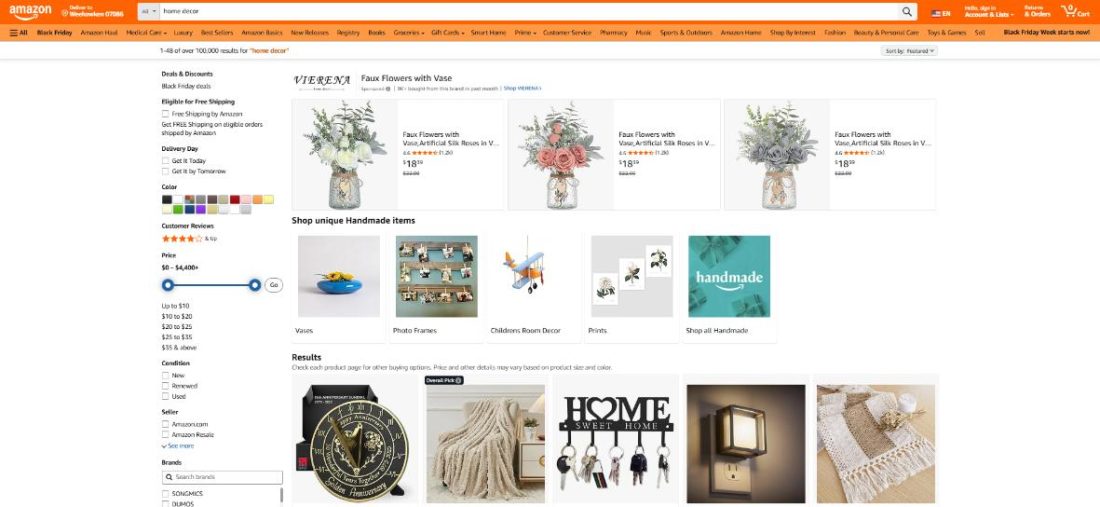
Home categories are asymmetric. Small home gadgets and decor see discovery spikes on Prime Day (trial purchases, “treat yourself” buys). Large home furniture or appliances are Black Friday winners because shoppers treat them as planned purchases, holiday refreshes, or gifts.
Fulfillment hassles (returns, shipping windows) make Buy Box and delivery promises decisive in Q4; deep discounting without clear warranty/return framing often increases returns and reduces LTV.
3. Personal Care (skincare devices, grooming tools, consumables)
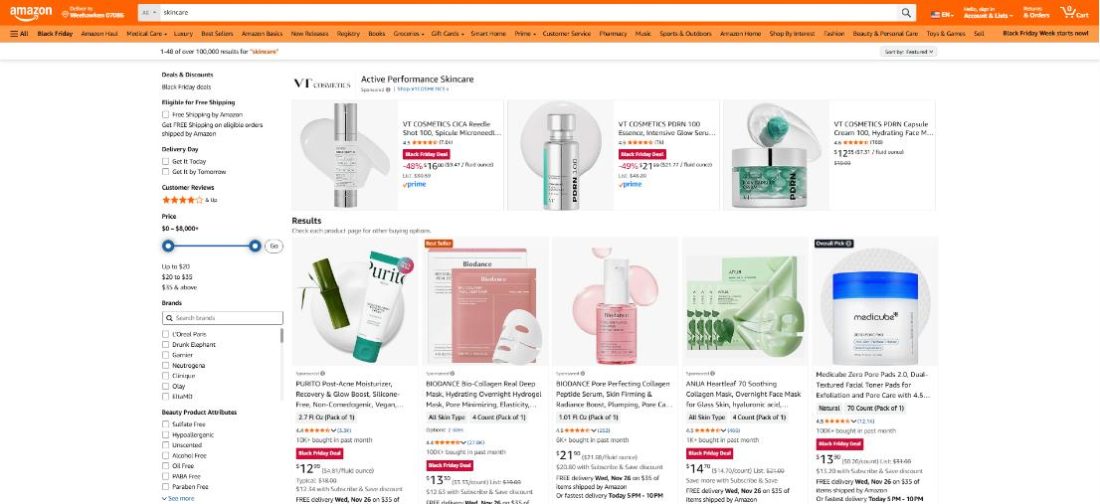
Personal care splits into durables (devices) and consumables (refills, subscription products). Prime Day works spectacularly for devices that benefit from impulse and trial and for subscription acquisition offers (first box discount).
Black Friday, however, is when consumers buy premium gift-ready kits and refill bulk packs. Return rates are generally lower for consumables, making TACoS more forgiving during Prime Day when CAC might be higher, but LTV potential improves with subscription capture.
Brand-driven vs. Impulse-driven category behavior
Brand-driven categories are ones where trust, reviews, and brand signals dominate purchase decisions (think premium electronics, luxury beauty, and established home appliance brands). These categories convert better on Black Friday because shoppers are validating purchases and looking for reliable delivery and service. Strategies like brand-protective Sponsored brand campaigns, guaranteed restock for top SKUs, and margin-preserving coupon stacks tied to warranty/installation offers.
Impulse-driven categories (small accessories, novelty kitchen tools, and impulse beauty buys) perform extremely well on Prime Day because Amazon’s event surfaces discovery. Tactics like aggressive Sponsored Display and DSP upper-funnel pushes in the 7–14 days before Prime Day, lightning bundle experiments, and a low-friction returns policy to reduce buyer hesitation.
For multi-SKU brands, treat each ASIN as either brand-driven or impulse-driven and run separate lifecycle playbooks. Do not apply a single promotion strategy across a mixed portfolio.
Rising category trends (smart home, sustainability, subscriptions)
Smart Home

Smart home remains high-velocity in both events but with different unit economics. Prime Day drives trial purchases of sensors, plugs, and entry-level hubs; the goal is ecosystem capture (get them using the platform). Black Friday is when consumers commit to integrated systems (security bundles, smart thermostats).
The Strategy is use Prime Day to acquire a device install base and collect telemetry (ATC install signals if you can instrument off-Amazon). Then during the Black Friday push, ecosystem upgrades and warranty bundles.
Sustainability-driven items

Sustainable or eco-focused items (reusable goods, low-waste beauty) often have higher AOV and better LTV but convert worse on pure-deal events because buyers look for perceived value parity. Use Prime Day for storytelling-driven discovery (native content, A+ pages highlighting lifecycle).
For Black Friday, package sustainable products in giftable bundles and lead with verified impact metrics. Consumers gift sustainability only when it’s framed as a premium, purposeful choice.
Subscription-based products
Subscriptions excel on Prime Day for acquisition because trial discounts reduce CAC and because consumers are in personal-purchase mode. Use loss-leader first-box pricing and aggressively capture post-purchase emails and DSP retargeting segments.
Black Friday is retention-churn territory; highlight multi-month bundles, pause/cancel flexibility, and gifting options to capture holiday subscribers.
International market nuances (US vs UK/DE/JP/IN)
Selling during Prime Day vs Black Friday is like understanding the local shopping psychology behind each marketplace. The mistake most sellers make is assuming the US approach can be copied everywhere else.
It can’t. Each region responds differently to discounts, messaging, delivery expectations, and even trust signals. And the good news is small adjustments tailored to each market can create immediate improvements in CTR and overall event profitability.
Here’s how each region behaves, and what you can adjust today to see noticeable lift before the event starts.
United States (US): American shoppers lean hard into discounts, especially as the event leads into the broader holiday window. High-AOV categories like electronics, kitchen appliances, and wellness usually see their biggest margins during Black Friday.
What you should change today for fast impact
Strengthen your deal visibility signals. US shoppers respond instantly to clean pricing psychology: strong strikethroughs, coupon stacking, and high-contrast hero images that highlight savings.
As mentioned before, if you optimize your top 180 characters to clearly explain value (“Save $20 today,” “25% off bundles”), you’ll see improvements in CTR almost immediately. It’s a marketplace where aggressive clarity wins.
United Kingdom / Germany (UK/DE): Prime Day often overlaps with regional mid-year sale periods, and Black Friday performs well but tends to be more compressed. Shoppers here scrutinize warranty, shipping reliability, and return policies more than US buyers.
What you should change today
Add clearer copy around delivery reliability and post-purchase support. In these markets, simply emphasizing “free returns,” “2-year warranty,” or “fast insured shipping” in your bullets or A+ modules can move conversion rates within hours.
Test a more transparent tone European buyers reward brands that communicate responsibly rather than pushing urgency.
Japan (JP): Prime Day in Japan doesn’t trigger the same impulse-buying behavior seen in the US, especially for accessories or gadget add-ons. Black Friday is growing but still secondary to the broader holiday season.
What you should change today
Reinforce credibility. Make sure your listings display strong trust signals, consistent Q&A responses, clean review sentiment, and culturally aligned messaging. Also optimize for local payment preferences.
Highlight Amazon Pay availability or installment options where relevant. These adjustments often lead to immediate improvements in add-to-cart rates in JP, because shoppers want reassurance more than discounts.
India (IN): Prime Day overlaps with Big Billion Day and other major sale periods. Indian shoppers are extremely price sensitive but equally skeptical about delivery timelines and seller reliability.
What you should change today
Drop your hero price point slightly and push faster shipping promises. Even a marginal price adjustment of sometimes ₹50–₹100 can swing CTR in your favor. If you use regional 3PL partners or AWD to tighten delivery promises, make sure that shows on your detail page.
Indian shoppers react instantly to “Deliver tomorrow” and “Fast, free delivery.” You’ll see a quicker rise here than almost any other market once shipping confidence improves.
Risk, gating, and operational constraints
Gated categories (medical equipment, beauty products, and supplements) require more time for approval and more monitoring of returns. Don’t use Prime Day as a time to accelerate the release of gated goods.
Use it to send interested users to waitlist captures and drive pre-launch traffic to your brand shop. To prevent delistings on Black Friday, make sure all documentation and compliance are complete.
On Black Friday, keep a close eye out for MAP violations because automated undercutters and unapproved resellers have the potential to destroy profits. Use guardrail-equipped automatic repricing and Brand Registry safeguards.
When Should You Prioritize Each Event?
For Amazon sellers, the decision to prioritize Prime Day vs Black Friday isn’t a question of “which sells more.” It’s about strategic sequencing when to spend, when to scale, and when to hold your ground.
ROI by Category
Your brand’s maturity and product category are the two biggest factors determining event ROI.
For emerging sellers, Prime Day offers a safer starting point. The ad auctions are still unpredictable, but the system is more limited, you’re mostly competing within Amazon’s walls. This makes it the perfect event to test creativity, pricing elasticity, and keyword performance without getting drowned out by Q4’s ad inflation.
In contrast, Black Friday is a volume-driven event where efficiency often gives way to aggression. Because CPCs rise steeply, discount thresholds widen, and purchase intent skyrockets, but only for brands that can sustain it.
The average conversion rate across consumer electronics and personal care categories can double compared to July, but margins can shrink by up to 40%. Black Friday rewards brands that already have the ad data, customer lists, and fulfillment predictability to survive an inventory rush without sacrificing profitability.
What matters more for Prime Day for new sellers?
For a new seller, the path to long-term success runs through visibility. Prime Day is designed for this kind of strategic exposure. Shoppers approach it with curiosity, as they are open to trying new brands and new categories if the price feels right.
When shoppers are in a discovery-driven mindset, that allows smaller sellers to gain traction without needing extreme price cuts. Sponsored brands, coupons, and moderate Lightning Deals work best here because the competition is predictive. Every impression contributes to building organic reach, especially if your post-event retargeting and review collection systems are tight.
However, jumping right into Black Friday as a new seller is risky. It’s a price war, which is hard to win, dominated by well-established sellers who can afford to risk margins to protect market share. Competing here without a strong ad history, review base often burns more cash than it returns.
How does Advanced Brands control margin and data flow?
Seasoned sellers utilize both occasions, but for distinct objectives. In order to determine which SKUs are ready for liquidation and which still have elasticity, Prime Day turns into a testing moment. Before Q4 arrives, it’s also a good idea to stress test fulfillment systems.
The most astute companies use Prime Day as a data refinery, gathering click-through exceptions, keyword patterns, and consumer profiles that go straight into their November DSP retargeting pools. They already know what price criteria are effective and who is most likely to convert by the time Black Friday rolls around.
It is this data consistency that protects margin accuracy. Advanced brands use ad sequencing over two main retail peaks to influence pre-qualified consumers and create demand rather than responding to competition.
When to Go “All In”
If your business is in its growth stage, still optimizing PPC efficiency and product positioning, Prime Day should be your flagship event. It gives you measurable returns and sets you up for sustained ranking and ad performance gains in Q4.
If your brand is already established, you can scale during Black Friday. That’s when your prior Prime Day learnings transform into market dominance. You may sacrifice margin, but you’ll gain share-of-wallet and frequent buyers who often return post-holiday for repeat purchases.
Final Thoughts
Now, here’s the thing Prime Day vs Black Friday are like the two sides of the same coin. One side tells you how well your brand can capture attention; the other, if you can make or break your brand with that attention.
Because that’s where ecommerce is heading. The lines are fading. Deals drop earlier, ad cycles overlap, and shoppers don’t care what the calendar says anymore, all they care about is value and timing that feels right.
Honestly, with Amazon Prime Day vs Black Friday or any event, as a seller you know that the right intelligence and execution matter more than ever. So why does SellerApp fit naturally into this story? Whether you’re running your first Prime Day or prepping up for your most aggressive Black Friday yet, SellerApp helps you operate with clarity
Saying that, you get the data that actually helps you. You need to take care of pricing intelligence, keyword optimization, audience behavior, and inventory alerts, and you get them at the speed these events demand. If you don’t have the time or team to execute all of this yourself, SellerApp’s managed services step in with a system built on hundreds of Q4 campaigns. You get experts who’ve handled everything in between.


